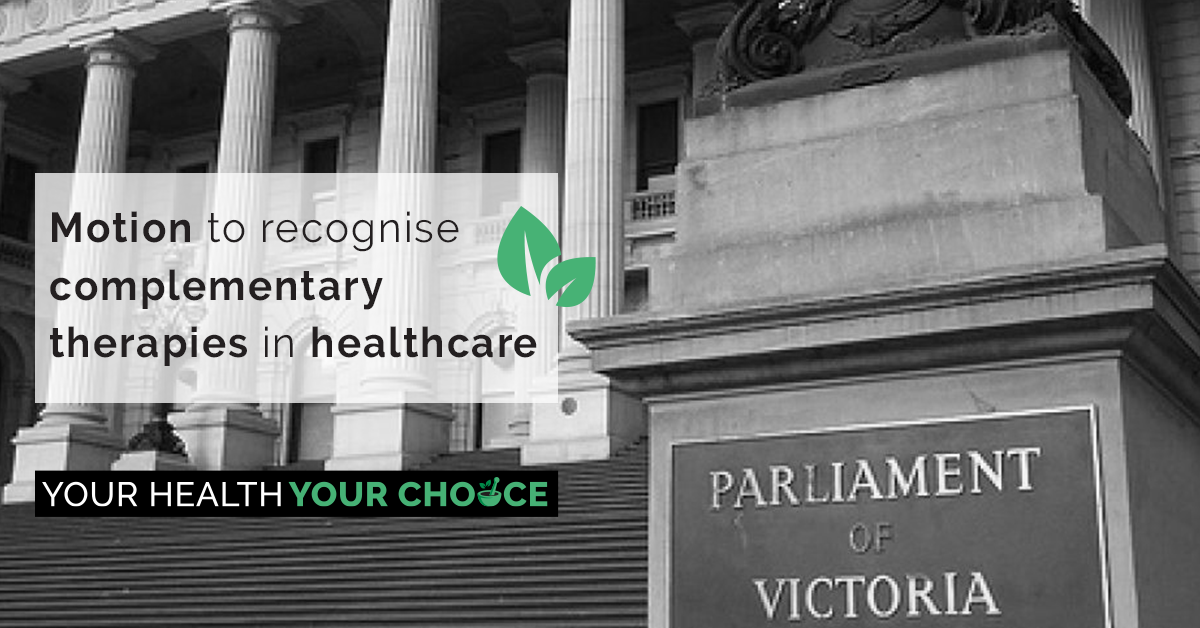Victorian MP introduces motion to recognise complementary therapies in healthcare

Victorian MP Dr Catherine Cumming* has tabled a motion urging the Government to recognise the effectiveness and role of complementary therapies in Victoria’s healthcare system.
Dr Catherine Cumming’s motion, tabled on 26 May 2021, notes that complementary therapies demonstrate effectiveness in areas of burden to the health system, urging the government to meet user demands with safe and reliable choices in ensuring that key health policies address complementary therapies.
“This motion puts it on the record that the government has a role in meeting user demands with safe and reliable choices, and in ensuring that key health policies address complementary therapies, that all health practitioners are appropriately trained and registered, that consumers are provided with up-to- date and accurate information about their choices for different types of products and treatments and that the safety of new products and treatments and their benefits are vigorously reviewed and evaluated.”
She has urged the Government to recognise the increasing financial burden of preventable illnesses and the COVID-19 pandemic on the Victorian health system, saying that complementary medicines are often cost-effective and less invasive than other options
A previous motion introduced by Dr Cumming on 16 October 2020 resulted in a 19-19 divided vote. It called for the appointment of a select committee to inquire into the strategic direction for complementary therapies within the Victorian health system.
Following is the full text of Dr Cumming’s 26 May 2021 motion:
Dr CUMMING (Western Metropolitan) (11:51): I rise to speak to notice of motion 557 standing in my name. I move:
That this house:
(1) recognises the increasing financial burden on the Victorian health system from preventable illnesses and the COVID-19 pandemic;
(2) notes that complementary therapies:
(a) demonstrate effectiveness in areas of burden to the health system;
(b) is a sector worth $9 billion that supports domestic jobs, farming, manufacturing, research and exports;
(c) are often cost effective and less invasive;
(3) further notes that all levels of government have a role in:
(a) acknowledging and meeting user demands with safe and reliable choices;
(b) ensuring key health policies address complementary therapies;
(c) ensuring that all health practitioners are appropriately trained and registered;
(d) providing up-to-date and accurate information to consumers about their choices for different types of products and treatments;
(e) rigorously reviewing and evaluating the safety of new products and treatments and their benefits;
(4) calls on the Department of Health to provide:
(a) strong and up-to-date advice for consumers regarding effectiveness and safety of complementary therapies; and
(b) fact sheets on complementary therapies, including Indigenous medicine, to improve public awareness.
Last October I called on this chamber to recognise the increasing financial burden on the Victorian health system from preventable illnesses and the COVID-19 pandemic and for the creation of a task force. Today I put another motion to you on complementary therapies. Complementary therapies refer to a wider range outside of Australia’s predominant medical model, and they are often used alongside conventional medicines or treatments. They can be called complementary medicines, alternative therapies, alternative medicines, holistic therapies and traditional medicines. These therapies are widely used by Victorians.
Two out of every three Australians use them, mostly to manage symptoms of chronic illness, for prevention of illness and to improve their health and wellbeing, so 25 of the sitting members of this chamber may have used complementary therapies. You may have meditated or used a naturopath, a chiropractor, a myotherapist or even an acupuncturist. According to the Australian Institute of Health and Welfare, chronic illnesses are becoming increasingly common and are a priority for action in the health sector. Our overall life expectancy has increased, but unfortunately 50 per cent of us suffer at least one of the eight major chronic conditions, being arthritis, asthma, back pain, cancer, cardiovascular disease, chronic obstructive pulmonary disease, diabetes and mental health conditions.
By the age of 65, 60 per cent have at least two chronic illnesses. Now, chronic illness costs the Australian health system more than $320 million each year in avoidable hospital admissions, according to the Grattan Institute report. What is most important to note is that almost all of these conditions are preventable, and according to this data we will be living longer but with potentially poorer quality of life. The growing number of chronic illnesses and the associated pressure that they place on health spending is by far exceeding the capacity to meet the needs of those suffering.
The complementary therapies industry is worth $9 billion a year and supports domestic jobs, farming, manufacturing, research and exports. The combined complementary therapies workforce is over 27 000 people and growing. It is outstripping the economy in terms of growth, so it is concerning it is largely ignored by our healthcare policy and our healthcare system as a whole. The Victorian Public Health and Wellbeing Plan 2019–2023, Victoria’s International Health Strategy 2016–2020 and Victoria’s health and medical research strategy 2016–20, our current key health policies, do not address complementary therapies at this time.
When looking at the suitability of integrating complementary therapies, we must also acknowledge that Australia is highly culturally and linguistically diverse. We cannot ignore that the data indicates that these communities are also more likely to experience poorer health than other Australians. The life expectancy of Victorians is almost two years above the national Australian average, but there is a huge gap between the life expectancy of Aboriginal and Torres Strait Islander and non-Indigenous populations—on average eight years. The gap is unacceptable. For Indigenous and culturally and linguistically diverse communities there is often a sense that conventional healthcare providers do not recognise or understand their cultural needs or approve of some of their culturally appropriate treatments and medicines. I appreciate the government’s effort to increase the number of Aboriginal and Torres Strait Islander health workers in Victoria. Our state has had the largest increase, nearly doubling between 2006 and 2011. The importance of the health of our First Nations people should not be lip-service. Sixty-five thousand years of wisdom must not be lost. To effectively address health
inadequacies our health system must consider and address the impact of cultural influences on patients and their healthcare decisions.
This motion puts it on the record that the government has a role in meeting user demands with safe and reliable choices, and in ensuring that key health policies address complementary therapies, that all health practitioners are appropriately trained and registered, that consumers are provided with up-to-date and accurate information about their choices for different types of products and treatments and that the safety of new products and treatments and their benefits are vigorously reviewed and evaluated.
Business interrupted pursuant to sessional orders.
* Dr Catherine Cumming is the Independent Member of the Victorian Legislative Council (Upper House of the Parliament of Victoria).
« Return to News & Features
